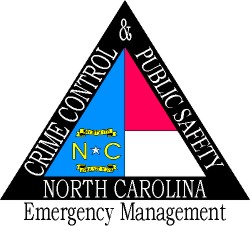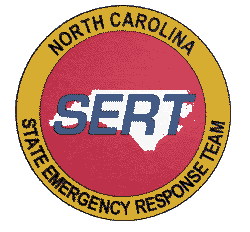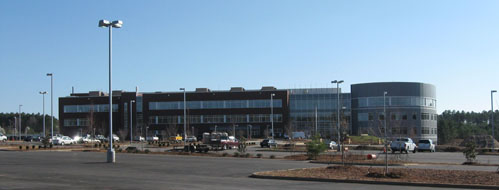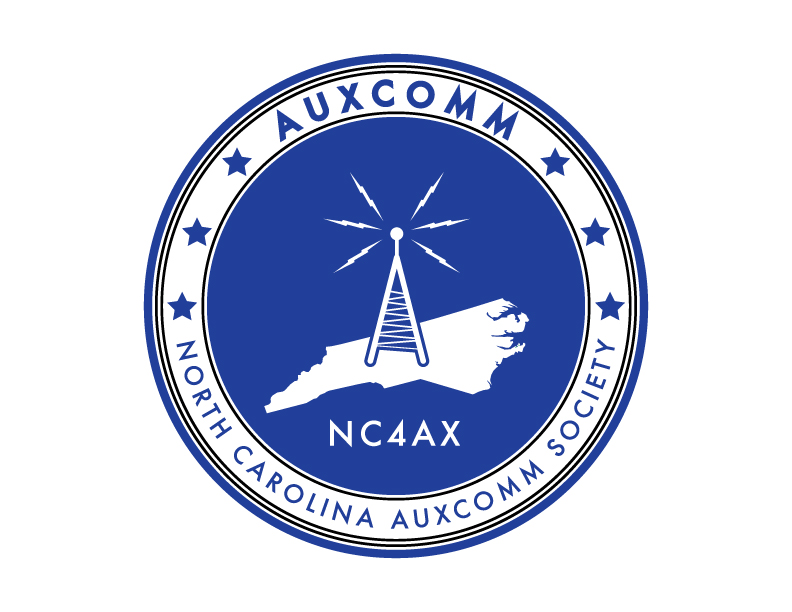Wake County AUXCOMM
- Home
- About
- AUXCOMM Nets
- News
- Training
- ICS 214 Incident Activity Tracking Log
- ICS review
- Mandatory NIMS Training
- Standardized Phonetic Alphabet
- Standardized Prowords
- ICS-213 Message Handling
- AUXCOMM Power Connector
- Basic Radio Procedures for Activations
- Activation Levels
- State EOC Emergency Operations Plan
- Emergency Communications Declarations
- Go Kit
- Repeaters
- Join
- Archives
About
|
| Wake County AUXCOMM needs the help of all Amateur Radio Operators in/around Wake County. Our served agencies rely upon us to provide backup communications support during activations and drills. |
What AUXCOMM does in 50 words or less:
AUXCOMM provides backup communications when other systems fail or become overloaded. We do this primarily for State and County Emergency Management, and through them, a variety of agencies like the American Red Cross.
AUXCOMM can also provide some primary information – weather, damage, anything our “served agencies” ask for.
AUXCOMM Structure:
We’ll build this pyramid from the bottom up.
At the base of the AUXCOMM pyramid is the County AUXCOMM Coordinator, and all the Auxiliary Emergency Communicators who man the EOCs, Command Posts, Staging Areas, shelters and anywhere else we get sent to provide communications. Each county has an AUXCOMM Coordinator in charge of the AUXCOMM team. Working with the AUXCOMM Coordinator are Deputy Coordinators who may have specific responsibilities. Frank Pleshe N3FRP is the AUXCOMM Coordinator for Wake County. ( See the Leadership page for info.) |
|
- Areas and Branches
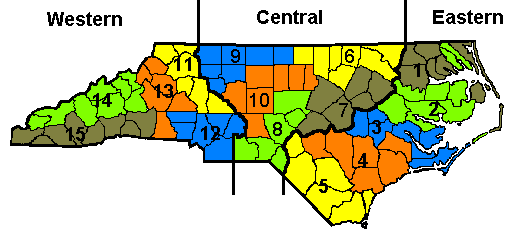
- Above the county level, North Carolina AUXCOMM is divided into three Branches, and 15 Areas. This division mirrors the way North Carolina Emergency Management has divided the state. Wake County is in Area 7, which is in the Central Branch.Area 7 has an
Who can join AUXCOMM?
You do not need to be a member of ARES, RACES, MARS, or any local clubs, though we will be working closely with these groups for training and recruiting.
Amateur Radio’s place in the State EOC
NCEM Communications Channels
- The public telephone system is the primary communications channel between NCEM and the rest of the state. It is also the most vulnerable in the event of a disaster.
- The Internet-based WebEOC management system. This connects all participants in an Incident with a common management/communications environment. Since this is infrastructure-based, it is subject to interruptions or outright failure. WebEOC messages are digital and are described as “record traffic”.
- Viper Tactical Network allows direct voice communications between the NCEM 24 Hour Operations Center and certain counties and municipalities via microwave-connected radios located in the local geographical areas. Those radios operate on the local public safety frequencies via the microwave remote-control.
- 800 MHz VIPER trunked radio system. This system is currently being implemented across the state, beginning at the East coast and working westward. This provides good interoperability between others users of the system, but is infrastructure-based and subject to interruption.
- A system of satellite radio/telephones now provides improved coverage around the state. Each county has a satellite radio terminal, often located in the county 911 center, not necessarily at the EOC. And the satellite system can be blocked by severe weather, or suffer other malfunctions.
- Amateur Radio provides the backup for these channels. Since Amateur Radio is a totally self-contained system and the only non-infrastructure-based network, the only way it can fail is through lack of interest on the part of hams themselves.
- MARS Winlink is a new Amateur Radio-based “email via HF radio” system that provides NCEM with a robust email system that overlays the normal State email system in certain NCEM facilities. This system operates entirely free of the conventional local/regional Internet system, using US Military MARS (Military Affiliate Radio System) frequencies allocated to NCEM via Agency licenses issued by the US Army MARS command at Ft. Huachaca, AZ. Amateur Radio operators installed and configured the equipment and maintain it.
What information do we communicate?
Anything needed by the agencies we serve. This may be a request for supplies, a team to rebuild a bridge, an update on evacuation progress, shelter status, weather conditions, damage assessment… anything.
What tools do we have?
- The State EOC Station – HF, VHF and UHF, HF Winlink
- Wake County EOC Station – 2 VHF-UHF Dual-band radios.
- Communications Networks:
- Tarheel Net on 3923 kHz and 7232 kHz
- NTS Traffic Nets
- VHF – local repeaters and linked repeater networks
- YOU – your home, mobile and portable stations
Which brings us to the discussion of your capability. Some of us have just a handheld VHF-FM radio (with several spare batteries?). Some have full HF-VHF systems at home, with generator or battery power for extended loss of power. Regardless of your stations scope or complexity, have you developed the knowledge and skills to use them flexibly in an emergency?
In particular, most of us use one or two repeaters regularly for ragchewing. We are familiar with their coverage, features, tones and other characteristics. But when it comes time to use another repeater, too many of us are lost. We don’t know the frequency, the location, the offset, the tones. We don’t have them programmed into memory.
That may be good enough for ragchewing, but it’s not good enough for a flexible ARES operator. You may be sent to any repeater providing county coverage during a disaster. If you need to be trained on the fly in that situation, we waste precious time. So please get to know the local repeaters, and try to use all of them at least occasionally.
We have prepared a list of “recommended repeaters” in and around Wake County, and a list of machines covering a wider area is available at: http://www.rars.org/repeater/trirpt.htm. (“Recommended” means that we recommend that you program these repeaters in memory, and gain some experience with their coverage and features.)
- Future facilities
- MARS/Ham VHF Winlink RMS
- MARS/Ham UHF Winlink RMS
Why are these future facilities? People are using them now, aren’t they?
Yes, and we may use them on an ad-hoc basis. But to have a regular place in our communications plan, we need enough stations and trained operators to be able to man these modes for the duration of an emergency.
When we get called up…
How long will we be needed? Our general objective is 72 hours of continuous coverage at both the State and County EOCs. Shifts are 4 to 6 hours, with two hams per shift at each location. Then there are the field locations… This is a lot of manpower. And clearly the 72 hour figure is just a target. Actual callups may be shorter or occasionally much longer. We want to identify in advance the people we need for three days of operation.
How it will work:
State or County Emergency Management will notify the EC or Assistant ECs that we should put our team on Stand-By. That’s assuming that a disaster gives some advance warning (hurricane, ice storm). Some disasters give no warning, and we’ll immediately become Active (nuclear plant disaster, airplane crash, earthquake).
The EC and assistants will begin making phone calls to hams who have registered (that’s you), filling out a duty roster for the time needed. We will also probably recruit hams with bulletins on the local repeaters.
When you are called up, you’ll need to know a few things about how to fill your shift.
- Wake County EOC
The county EOC is in the basement of a downtown building. Operators will receive directions to this secure area when they are trained.During activations, there is usually food available at the County EOC but we can’t promise it. Dress in layers – it can be warm or it can be chilly.
- Field Locations
Wake County Emergency Management may set up Command Posts, Staging Areas, shelters, or other remote facilities that need Amateur Radio communications. These are typically at Fire Stations, town halls or Police Departments, schools and hospitals. If you get that assignment, you will receive directions from the EOC operator or an Assistant EC.Hams filling Field jobs will need to be flexible with both radio equipment and their personal needs. Communications will typically be on local repeaters. But handheld radios with “rubber ducks” may not reach repeaters from many indoor locations. You may need to set up a temporary antenna and run coax into a building. Crossband repeat may be an option. Some locations will have permanent Amateur antennas and perhaps power supplies set up for AUXCOMM.
- State EOC
The State EOC is located at 1636 Gold Star Drive Raleigh, North Carolina 27607.
Operating the State EOC Station
- HF: The Tarheel Emergency Net on 3923 kHz (80 meters) is the North Carolina statewide ARES net. During widespread emergencies, it will be active 24 hours per day, and we will monitor it continuously. Routinely, the Tarheel net operates daily at 7:30 pm. All properly licensed stations are welcome to check in.
The 80 meter band supports propagation around the state most of the time, although in the early afternoon signals might get very weak. The Tarheel Net may move to 40 meters, at 7232 kHz, in those times. Or you may need a relay station to move traffic between stations who can’t hear each other. The State EOC HF station is not a particularly good performer, due to long feedlines, a lot of clutter around the antenna and substantial RF noise from elevator motors and typical urban QRN. We may ask for backup stations operating from home who can relay to the State EOC on VHF or landline. But we will always try to staff the HF station anyway.The Tarheel Net Manager will provide Net Control Stations for the duration of the activation. The State EOC station should not be Net Control. If you are interested in acting as a Tarheel Net Control from your home station, you should participate regularly and you’ll find ample opportunity.
During activations, stations from across the state monitor the Tarheel net. You will be particularly interested in stations at County EOCs, NCEM Branch Offices, staging areas and other “official” locations. Most of the traffic to and from the State EOC will be from these stations. Sometimes, though, you’ll get valuable information from other “non-official” hams – weather conditions, damage reports and such.
However, some hams will think of the EOC station as their personal link to emergency services. You’ll need to discourage this. We don’t take reports like “a tree down blocking my street”. This traffic should be reported to local authorities. Other hams on frequency may assist in relaying that kind of traffic. We will post a list of local ARES nets and repeaters to direct individual hams to for local traffic.
- VHF/UHF: The State EOC will monitor the 146.88 repeater for communications with County EOCs and other official stations within range. Wake County ARES may establish a Net Control if repeater traffic is busy. SKYWARN may supply the Net Control if there is weather related traffic in their coverage area. The EOC station should not be Net Control. However, if traffic is light, the repeater may be open to normal use with no Net Control, and the EOC operator will simply monitor for calls.
The second VHF radio, and the UHF side of the dual-band radio, can be used to reach other repeaters or linking systems for coverage targeted at specific areas. We will post a list of repeaters and frequencies that the State EOC station can be expected to reach during normal propagation conditions. We will also post information on using repeater linking systems available.
Additional information is available here.
- Traffic: Excepting immediate Tactical Messages (“Do you have contact with Brunswick County?”), messages sent to the State EOC or the any of the three Branch offices (RCCs during an Emergency) should be in ICS-213 format.
- All messages sent via Amateur Radio to or from from any person or activity desk (Operations, Logistics, MAC, etc.) at the State EOC are entered into the WebEOC system by the Ham Operator that received the message. Similarly, outgoing messages or other Tasks are sent to the Amateur Radio terminal and are completed according to plan and instructions.
Operating the Wake County EOC Station
The Wake County EOC station is in a corner of the main EOC situation room. There are two Kenwood TM-V7A dual-band radios, installed in April, 2001 (the picture shows Karl K4LNX programming them to match the V7A at the State EOC).
On the air: The Wake County EOC monitors 145.39 (82.5 Hz tone) for Wake County ARES activity, and 146.88 to communicate with the State EOC. Other repeaters may be designated depending on coverage required. Wake County ARES may establish a Net Control station on either or both repeaters, but the EOC station should not act as Net Control.
Additional information is available here.
WebEOC is also in use at the Wake County EOC and messages will be entered directly into that system by the Amateur Radio operator
The Wake County EOC also has a Message Officer, located in the middle of the room who may also request hard copies of message traffic.
Public Information
Our Amateur Radio operation will attract media attention at some point during most emergency activations at the EOC.
When Public Information Officers (PIOs) are available they will be responsible for management of all media contacts. In some circumstances reporters will appear at the Amateur station when the only people on duty are the on-air operators. Operators are not required to give an interview, and may just pass along some off-camera background information. If the decision is made to give an interview, here are some interviewing tips.
What to say:
The “Amateur Radio Story” is consistent and simple:
- We provide emergency communications when other resources go down or become overloaded. Two good recent examples occurred during Hurricanes Dennis and Floyd last year. During Dennis, Amateur Radio provided the only communications to Hatteras and Ocracoke Islands on the Outer Banks for two days. And during Floyd, Edgecombe County lost much of their police and emergency services communications to flooding, and relied on Amateur Radio for about a week.
- We can do this because we operate individual, self-contained stations that don’t rely on the power grid or the telephone network. We can communicate locally, across the state, or around the world.
- Amateur Radio is an all-volunteer effort. No one gets paid, and we use our own equipment. We enjoy using our equipment and skills to provide public service.
What not to say:
- Don’t give reporters the contents of any messages that have been passed, or the specifics of any communication in progress. They can listen in and record any communication while they are present at the EOC station. If they want specific information, direct them to the Amateur PIO or the EOC’s Public Information Office.
- Don’t use jargon or technical terms. Just speak plain English. Say “We can use this equipment to talk to Durham, Wilmington, western North Carolina, and around the world if we need to.” Don’t say “We’re talking to Wilmington on a linked VHF-FM repeater network, and we can reach Asheville on the HF sideband net on 75 meters.” That’s gibberish to the reporter and the audience.
During the media interview should you receive questions regarding non-amateur radio topics you should refer the media representative to the Joint Information Center. The number to the Center will be posted at the station during activations.
Personal Appearance
When assigned to the EOC, station operators should dress comfortably; however, we should always strive to make a good impression on the press and other EOC workers and State officials. Clothing including clean t-shirts and jeans will be appropriate. Please refrain from wearing clothing that may be offensive to others.
Well, that’s about it.. If you want to participate in Wake County AUXCOMM, please join.

